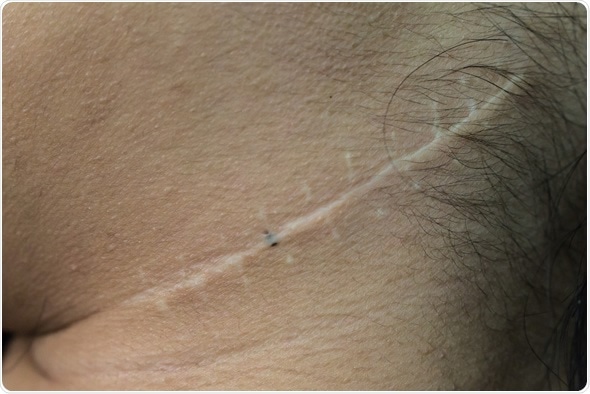For The Latest Medical News, Health News, Research News, COVID-19 News, Pharma News, Glaucoma News, Diabetes News, Herb News, Phytochemical News, Thailand Cannabis News, Cancer News, Doctor News, Thailand Hospital News, Oral Cancer News, Thailand Doctors
The formation of a scar is a natural part of the healing process following an injury to the skin as the body repairs the wound.
The appearance of the scar after the area has healed depends on several factors, including the type of injury, the area of the body affected and the healing process itself.
The type of injury is a significant determining factor for the formation of a scar.
Large incisions from surgical procedures or injuries from serious accidents are understandably more likely to result in the formation of a scar than minor cuts or scrapes to the skin.
Some body areas, such as the skin over the knee and elbow joints, are more likely to be affected by scarring.

It is important to understand the wound healing process when considering how to prevent the formation of scars. There are six significant phases of wound healing:
Transforming growth factor beta (TGF-β) is a mediator of the hemostatic inflammatory phase that plays a significant role in wound healing and the development of scars.
The transition from an immature to a mature scar takes place approximately six months to one year after the injury.
The most straightforward way to prevent the formation of scars is to limit injury to the skin.
Some people may wish to limit participation in activities that carry a high risk of injury or to wear adequate protective gear.
For surgical procedures, there should be adequate planning for the size and type of incision, as well as how to close the area while minimizing skin tension.
Soft tissue handling techniques should also be employed in order to minimize skin trauma.
There are four main areas that are recommended to promote the healing process and reduce scars, which include:
There are several techniques that can aid in skin healing and help to prevent the formation of scars following surgery or an injury to the skin.
Firstly, it is important to keep the affected area clean throughout the healing process. This helps to reduce the risk of infection and to remove any debris in the wound, which can interrupt healing.
Dermatologists recommend washing the area gently with mild soap and water regularly for this purpose. If the area is cleaned on a daily basis, anti-bacterial ointments are usually not necessary.
Keeping the wound moist with petroleum jelly or a similar ointment can also help to prevent the area from drying out. This is important because it helps to reduce the depth and size of any scarring, as well as to decrease the likelihood of scab formation, which can lengthen the healing process.
The wound should then be covered with an adhesive bandage to promote healing in the area and to prevent further injury or the entry of bacteria. The bandage should be changed daily.
Massaging the area is often recommended to help minimize scar formation through the optimization of the molecular environment. This is usually recommended 10-14 days after the skin injury.
The mechanical movement of the surrounding skin leads to the expression of enzymes, which help to degrade fibrotic tissue and increase the scar flexibility.
A massage is also useful to reduce pain associated with the injury due to the release of beta-endorphins.
After the healing process is complete and a scar has appeared, there are several things that can help to reduce the appearance of the scar on the skin.
Using adequate sun protection to reduce hyperpigmentation and reduce time for the scar to fade. This may also help to prevent melanogenesis in the scar due to exposure to ultraviolet light. However, sunscreen will not reduce “rubor perseverans,” the reddening of a scar not linked to inflammation that usually fades within a year of the injury.